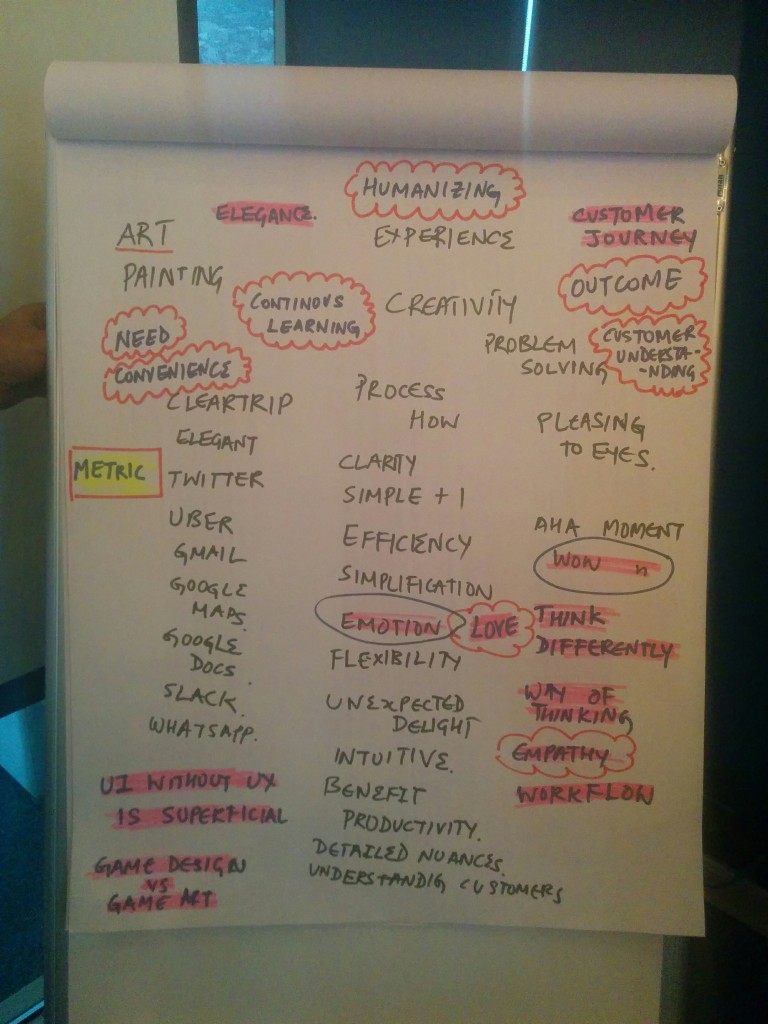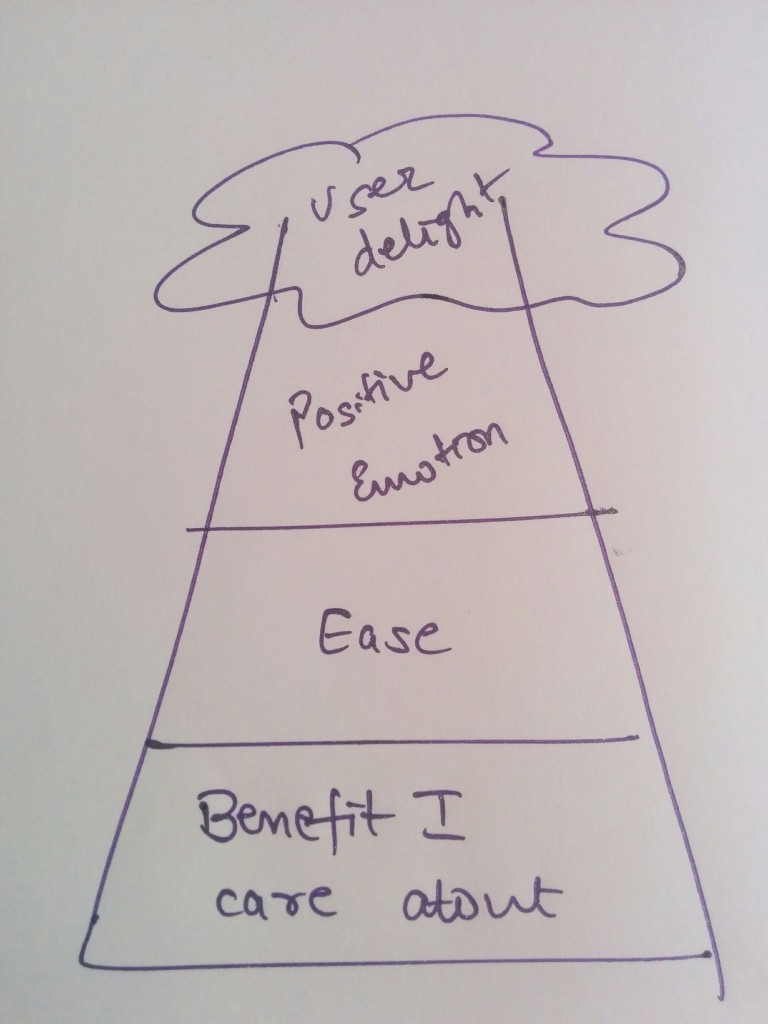When it comes to building a product, I had absolutely no experience before Pricebaba. While building Pricebaba.com I did learn many nuances and tricks for growth. I am grateful to the friends and mentors who have always helped us understand users better and how to build a great product. It was a pleasant coincidence last week when I got two opportunities to understand design better — first, I attended the Design Quicky Mumbai event hosted by 500 Startups and later in the week, iSpirt organised a roundtable session on Design Thinking. Deepa Bachu who is currently running a design consultancy firm Pensaar shared her 15+ years of experience working in the industry with brands like Intuit. Here are some key takeaways from that session.
Tracking Customer/Consumer Benefit Metric
According to Deepa, the key metric to chase / track is customer benefit metric (CBM). It’s simply how do you make your customer’s life easy. For Google, customer benefit metric would how be quickly it’s able serve the result and how relevant they are with user’s search query. This makes so much sense. If you look closely, all the updates Google has made are around that — be it with the Panda or Penguin update, to give the best result in minimal time.
Once you start thinking of serving your current users better, if they are truly benefitted with your product, they are going to use your product again. This leads to increase in MAU, decrease in bounce rate. All of your other metrics will fall in place automatically. Take marketplaces for example, they are serving two kind of customers — Merchants and Shoppers. Their key to success would be to make sure Merchants sell goods regularly and efficiently. They can enable this by reducing returns, empowering logistics and customer support. Whereas on the other hand making sure users get what they want at the right price and their journey to checkout is as smooth as it can be. For us, at Pricebaba it’s quite similar to marketplaces. Our customer benefit metric would be to make sure the returns on the partner’s platform are under control (thereby making sure conversions are higher). On other hand for users it would be how effectively we help them choose the best product for their needs. On Pricebaba a user can be overwhelmed by 175 products from the same manufacturer (eg: see Samsung Phones), our advanced filters is a way to help our users narrow their purchase decision faster. However for us bigger boost comes from helping the user get the top 4 or 8 products accurately in the first fold.
Design is not art, it’s not what you see
Deepa started her talk with how India is still not there when it comes to design thinking or product innovation. We do not think Design while building our Products, she suggested. On that remark, I jumped off my seat and said “this is not true”. People are talking about design. I sincerely believed this is now a key role in the product making, which was not the case 4 years ago. But, by the end of the session I realised she was right. Amongst many missing ingredients in our startup ecosystem, “design thinking” is one of them. We admire good looking design. We love clean, plain and simple. We look at design only by its visual perspective (is it appealing to the eye?). But, we forget to see the functionality or usability. That is arguably more important aspect of design.
 Throughout the session we had one white board on which we wrote what design means to us. We wrote apps we love and products which we consider as good examples and inspiration of good design. The participants initially thought design had a lot to do with ‘Art’, ‘Painting’ or ‘Creativity’. As we went further, our understanding evolved and ‘Emotion’, ‘Customer Journey’, ‘Elegance’ were the new keywords on the whiteboard.
Throughout the session we had one white board on which we wrote what design means to us. We wrote apps we love and products which we consider as good examples and inspiration of good design. The participants initially thought design had a lot to do with ‘Art’, ‘Painting’ or ‘Creativity’. As we went further, our understanding evolved and ‘Emotion’, ‘Customer Journey’, ‘Elegance’ were the new keywords on the whiteboard.
Going further it was ‘Customer understanding’, ‘Outcome’ and ‘Need’. Eventually, it all boiled down to one thing — ‘Metric’. If your numbers (in our case, Consumer Benefit Metric) are not increasing, all your Dev, BD or Marketing efforts don’t matter.
 There is this simple pyramid which is quite self-explanatory for product making. Bottom to Top it reads,
There is this simple pyramid which is quite self-explanatory for product making. Bottom to Top it reads,
- Benefit I care about: What is your service about? What is that one benefit you are serving your users with. The value proposition of your product. Nail that first. Achieve excellence. For my product Pricebaba, it is how a user get the best deal of a gadget suitable to their needs.
- Ease: How easily your users are able to get the benefit we talked about. How are you making things simpler for them. UX has a major part to play in phase. For us, it would be how easy are the choices we offer our users to narrow down on the right gadget.
- Positive Emotion: This is the part where actual UI comes into play. Users Delight will be the positive outcome of great UX and UI.
To sum it up, focus on what your business has to offer. What is that one benefit you are giving your users for which they will keep coming back to you. Create a good UX to make their journey to avail that benefit easier with great UI. There, you’ve got your “Ahaa!” moment from your users.
Users don’t know what they want
While building a product we often tend to build it the way we perceive things. We build a feature / flow in a certain way we think is the best. So many times we assume we know what users want. Taking some decisions from the gut is good. But building an entire product without interacting with actual users is not. You need to validate that gut-feel by talking to users. Observe them as use your product. We did a exercise where entire company went out on streets and interacted with users. We called it ‘Project Dragon Scroll’. We gave our potential users a simple task to search best price of a mobile phone. We were surprised to see so many of our myths and biases were getting resolved. Deepa shared tons of examples with us, making us realise that it is too difficult for a product to evolve if you don’t include your users in the process. For that you need to go and talk to them. Even understand what they are not saying. Ask questions. There are tons of tools for that. Just asking them question via surveys, making sure your Net Promoter Score is high might not help. Those online activities are needed, along with offline activities too. Also, you need to see the data on interaction, deep dive into metrics, logs, analytics to get a 360 degree view of things. Taking decisions based on only one of the above factors mentioned won’t help. You need to get out there on the streets, deep dive into analytics (GA, Clevertap, Mixpanel) and use online tools to see how users interact (A/B testing, Heatmaps and Surveys).
I am thankful to iSpirit for organising such wonderful event. I learnt a lot of things from this event. Thanks to Deepa who shared her experience and tools with us. It gave a new perspective to look at Design. If you want know anything more about this, feel free to catch me on Twitter @GanatraT
Tirthesh is co-founder of Pricebaba, one of the biggest product research and price comparison platform in India. A developer at heart, Tirthesh had the pleasure of being part of a journey since 2011, where a two-person team grew into a strong workforce in a matter of three years.













